A Comprehensive Analysis of Topical Food Policy: HSR and FOPNL
VerifiedAdded on 2022/10/11
|12
|3240
|11
Report
AI Summary
This report provides an in-depth analysis of food policy, specifically focusing on the Health Star Rating (HSR) system and Front of Package Nutrition Labels (FOPNL). It explores the purpose of these policies, which is to guide consumers in making informed decisions about food choices, thereby reducing diet-related non-communicable diseases. The report examines the conflicts of interest among stakeholders involved in formulating guidelines and discusses the HSR system's implementation in Australia, including nutrient profiling and its influence on public policies. It details the nutrients considered in the HSR system, its effectiveness, and its limitations, including criticisms regarding the differentiation between natural and added sugars. The report also compares nutrient, food, and diet-oriented worldviews, and discusses the application of nutrient profiling to FOPNL, the roles of key stakeholders, and the strengths and weaknesses of both systems. Finally, the report suggests revisions to the HSR system, including incorporating warning systems, aligning with the NOVA classification, and making the system mandatory, while also considering dietary guidelines and government arrangements.
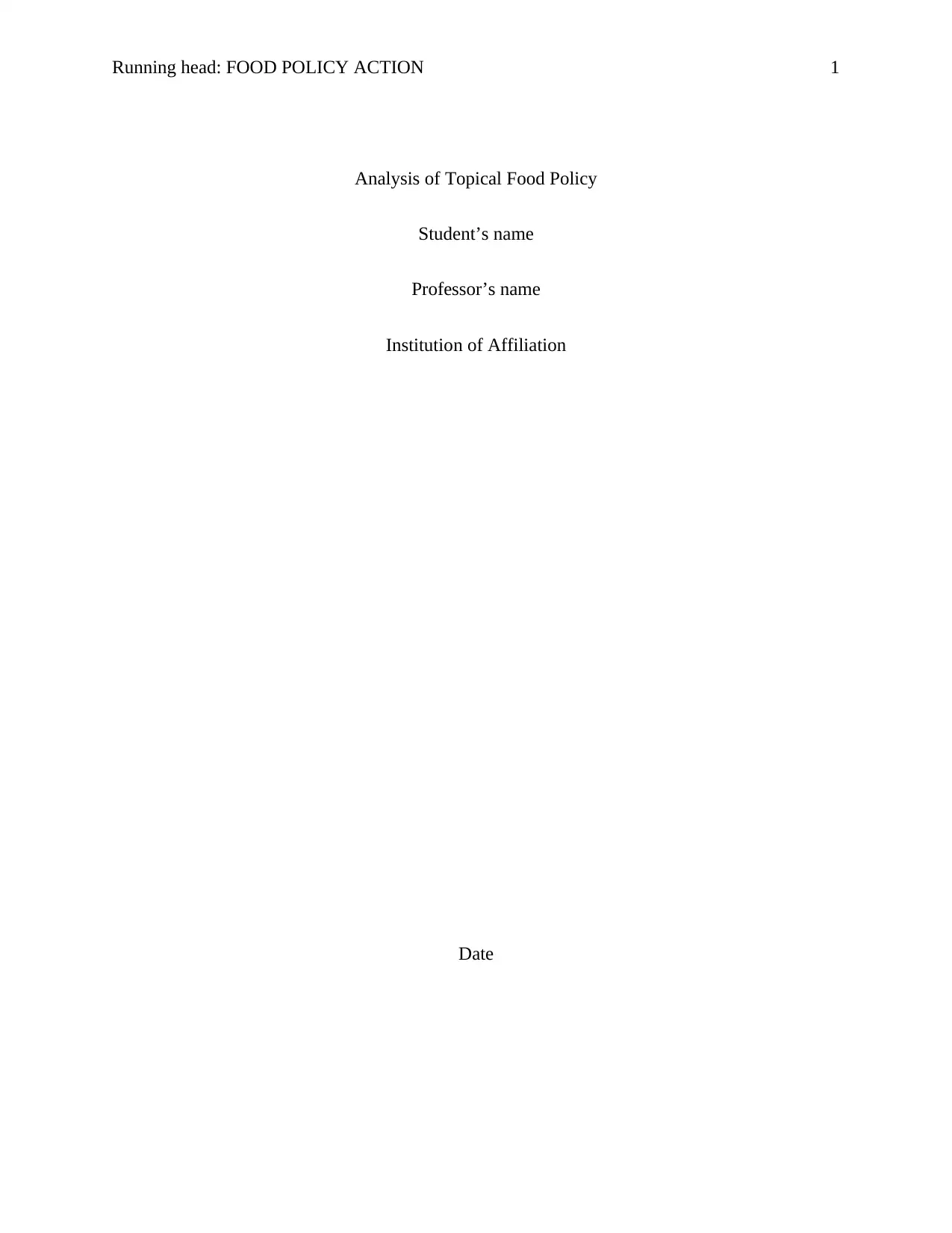
Running head: FOOD POLICY ACTION 1
Analysis of Topical Food Policy
Student’s name
Professor’s name
Institution of Affiliation
Date
Analysis of Topical Food Policy
Student’s name
Professor’s name
Institution of Affiliation
Date
Paraphrase This Document
Need a fresh take? Get an instant paraphrase of this document with our AI Paraphraser
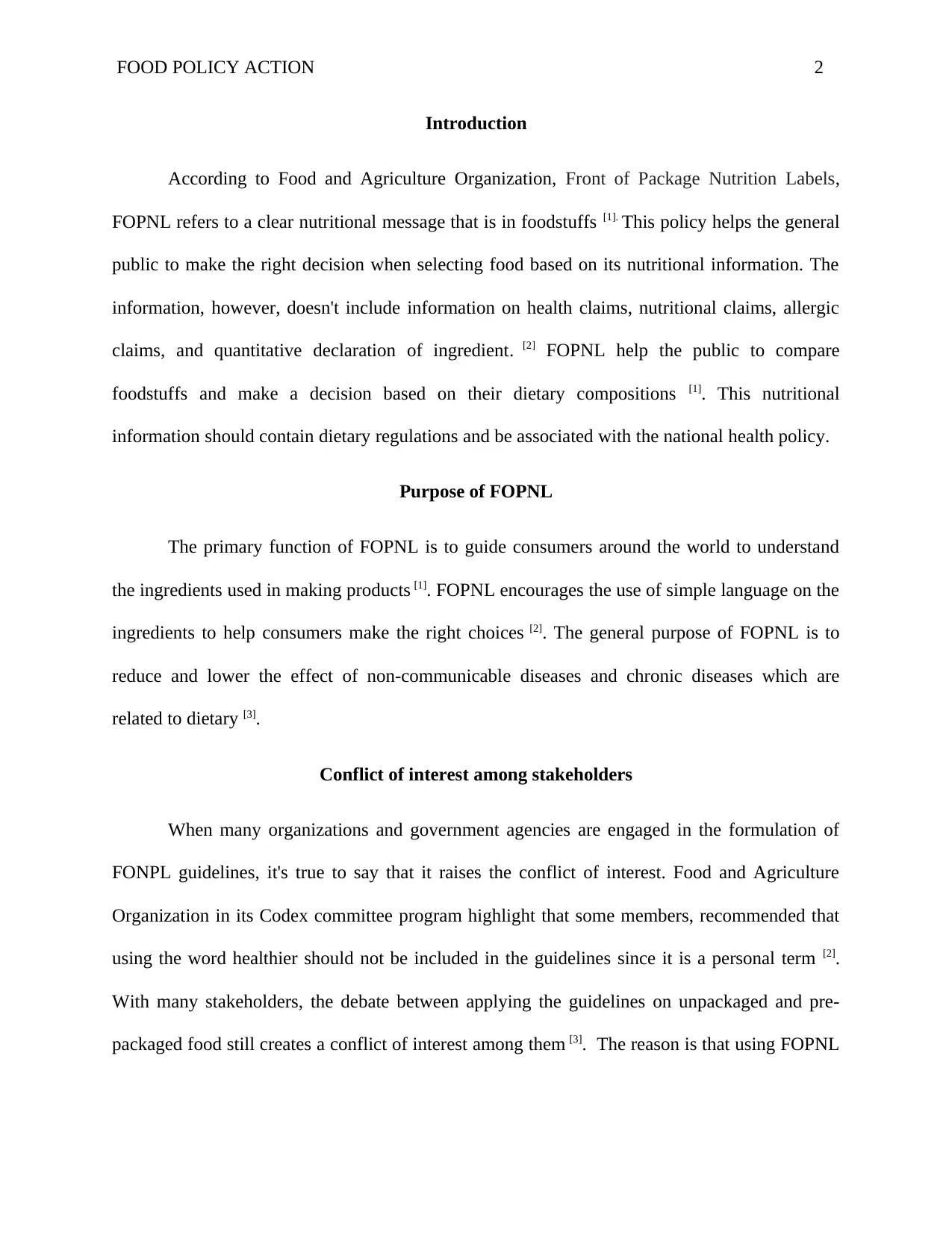
FOOD POLICY ACTION 2
Introduction
According to Food and Agriculture Organization, Front of Package Nutrition Labels,
FOPNL refers to a clear nutritional message that is in foodstuffs [1]. This policy helps the general
public to make the right decision when selecting food based on its nutritional information. The
information, however, doesn't include information on health claims, nutritional claims, allergic
claims, and quantitative declaration of ingredient. [2] FOPNL help the public to compare
foodstuffs and make a decision based on their dietary compositions [1]. This nutritional
information should contain dietary regulations and be associated with the national health policy.
Purpose of FOPNL
The primary function of FOPNL is to guide consumers around the world to understand
the ingredients used in making products [1]. FOPNL encourages the use of simple language on the
ingredients to help consumers make the right choices [2]. The general purpose of FOPNL is to
reduce and lower the effect of non-communicable diseases and chronic diseases which are
related to dietary [3].
Conflict of interest among stakeholders
When many organizations and government agencies are engaged in the formulation of
FONPL guidelines, it's true to say that it raises the conflict of interest. Food and Agriculture
Organization in its Codex committee program highlight that some members, recommended that
using the word healthier should not be included in the guidelines since it is a personal term [2].
With many stakeholders, the debate between applying the guidelines on unpackaged and pre-
packaged food still creates a conflict of interest among them [3]. The reason is that using FOPNL
Introduction
According to Food and Agriculture Organization, Front of Package Nutrition Labels,
FOPNL refers to a clear nutritional message that is in foodstuffs [1]. This policy helps the general
public to make the right decision when selecting food based on its nutritional information. The
information, however, doesn't include information on health claims, nutritional claims, allergic
claims, and quantitative declaration of ingredient. [2] FOPNL help the public to compare
foodstuffs and make a decision based on their dietary compositions [1]. This nutritional
information should contain dietary regulations and be associated with the national health policy.
Purpose of FOPNL
The primary function of FOPNL is to guide consumers around the world to understand
the ingredients used in making products [1]. FOPNL encourages the use of simple language on the
ingredients to help consumers make the right choices [2]. The general purpose of FOPNL is to
reduce and lower the effect of non-communicable diseases and chronic diseases which are
related to dietary [3].
Conflict of interest among stakeholders
When many organizations and government agencies are engaged in the formulation of
FONPL guidelines, it's true to say that it raises the conflict of interest. Food and Agriculture
Organization in its Codex committee program highlight that some members, recommended that
using the word healthier should not be included in the guidelines since it is a personal term [2].
With many stakeholders, the debate between applying the guidelines on unpackaged and pre-
packaged food still creates a conflict of interest among them [3]. The reason is that using FOPNL
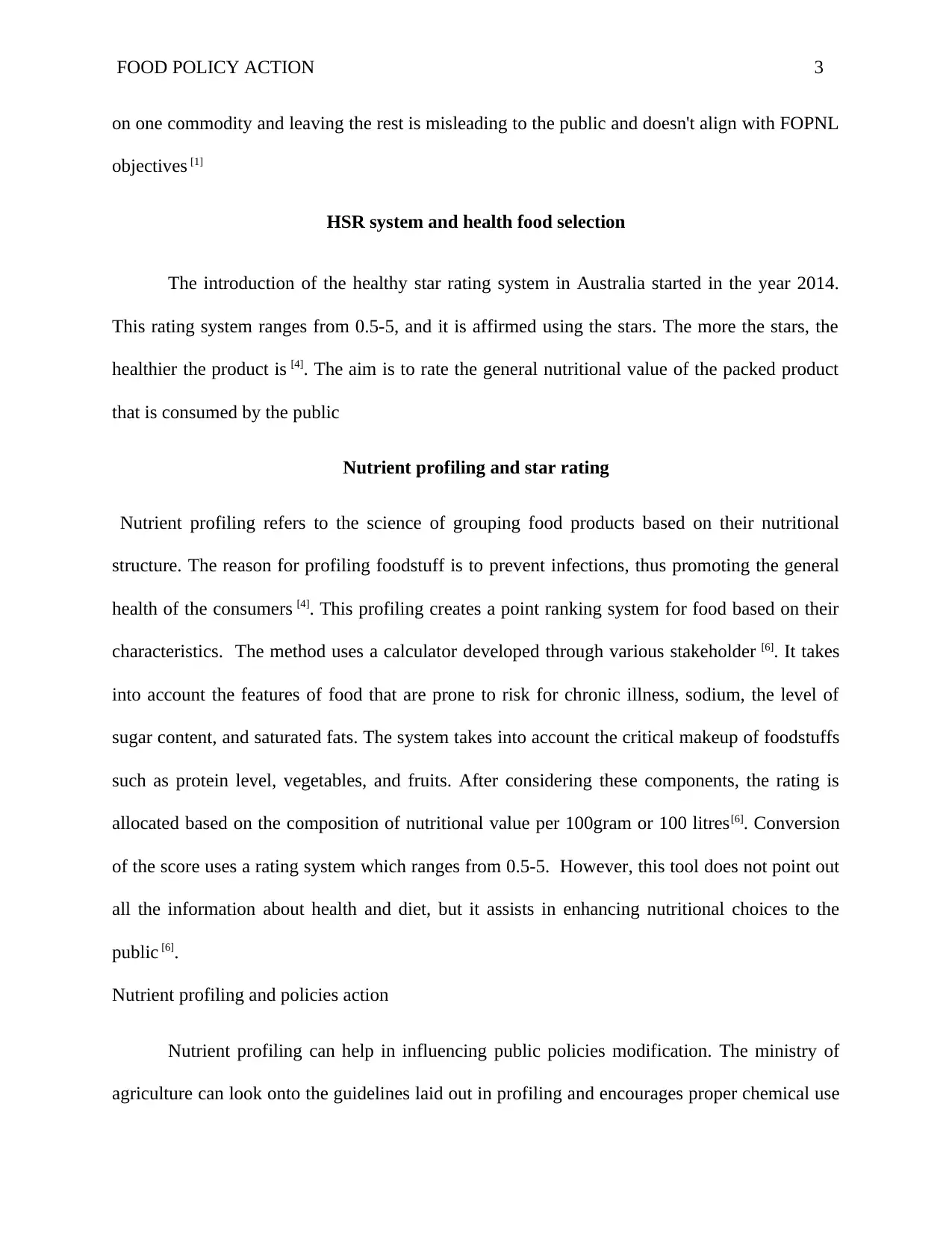
FOOD POLICY ACTION 3
on one commodity and leaving the rest is misleading to the public and doesn't align with FOPNL
objectives [1]
HSR system and health food selection
The introduction of the healthy star rating system in Australia started in the year 2014.
This rating system ranges from 0.5-5, and it is affirmed using the stars. The more the stars, the
healthier the product is [4]. The aim is to rate the general nutritional value of the packed product
that is consumed by the public
Nutrient profiling and star rating
Nutrient profiling refers to the science of grouping food products based on their nutritional
structure. The reason for profiling foodstuff is to prevent infections, thus promoting the general
health of the consumers [4]. This profiling creates a point ranking system for food based on their
characteristics. The method uses a calculator developed through various stakeholder [6]. It takes
into account the features of food that are prone to risk for chronic illness, sodium, the level of
sugar content, and saturated fats. The system takes into account the critical makeup of foodstuffs
such as protein level, vegetables, and fruits. After considering these components, the rating is
allocated based on the composition of nutritional value per 100gram or 100 litres[6]. Conversion
of the score uses a rating system which ranges from 0.5-5. However, this tool does not point out
all the information about health and diet, but it assists in enhancing nutritional choices to the
public [6].
Nutrient profiling and policies action
Nutrient profiling can help in influencing public policies modification. The ministry of
agriculture can look onto the guidelines laid out in profiling and encourages proper chemical use
on one commodity and leaving the rest is misleading to the public and doesn't align with FOPNL
objectives [1]
HSR system and health food selection
The introduction of the healthy star rating system in Australia started in the year 2014.
This rating system ranges from 0.5-5, and it is affirmed using the stars. The more the stars, the
healthier the product is [4]. The aim is to rate the general nutritional value of the packed product
that is consumed by the public
Nutrient profiling and star rating
Nutrient profiling refers to the science of grouping food products based on their nutritional
structure. The reason for profiling foodstuff is to prevent infections, thus promoting the general
health of the consumers [4]. This profiling creates a point ranking system for food based on their
characteristics. The method uses a calculator developed through various stakeholder [6]. It takes
into account the features of food that are prone to risk for chronic illness, sodium, the level of
sugar content, and saturated fats. The system takes into account the critical makeup of foodstuffs
such as protein level, vegetables, and fruits. After considering these components, the rating is
allocated based on the composition of nutritional value per 100gram or 100 litres[6]. Conversion
of the score uses a rating system which ranges from 0.5-5. However, this tool does not point out
all the information about health and diet, but it assists in enhancing nutritional choices to the
public [6].
Nutrient profiling and policies action
Nutrient profiling can help in influencing public policies modification. The ministry of
agriculture can look onto the guidelines laid out in profiling and encourages proper chemical use
⊘ This is a preview!⊘
Do you want full access?
Subscribe today to unlock all pages.

Trusted by 1+ million students worldwide
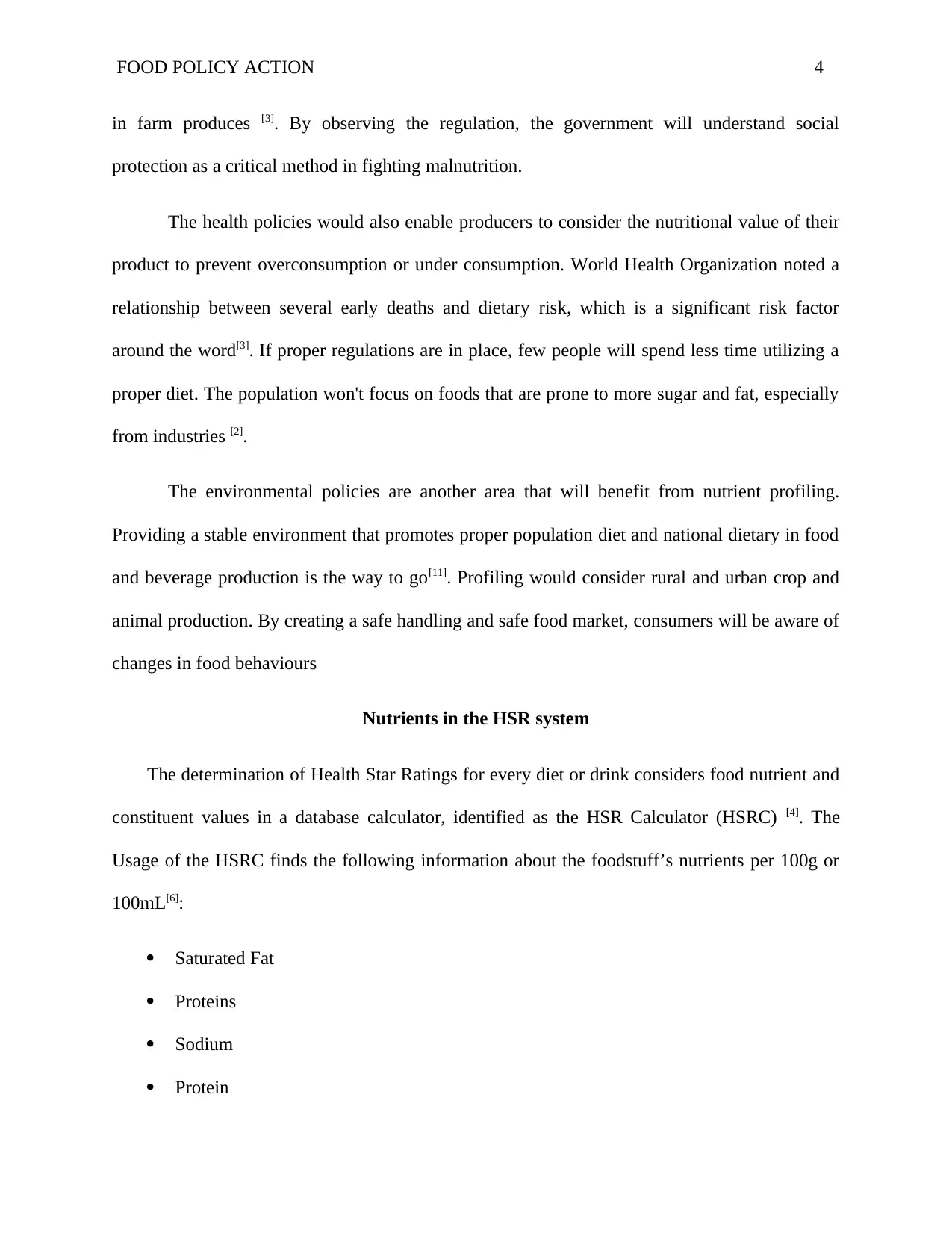
FOOD POLICY ACTION 4
in farm produces [3]. By observing the regulation, the government will understand social
protection as a critical method in fighting malnutrition.
The health policies would also enable producers to consider the nutritional value of their
product to prevent overconsumption or under consumption. World Health Organization noted a
relationship between several early deaths and dietary risk, which is a significant risk factor
around the word[3]. If proper regulations are in place, few people will spend less time utilizing a
proper diet. The population won't focus on foods that are prone to more sugar and fat, especially
from industries [2].
The environmental policies are another area that will benefit from nutrient profiling.
Providing a stable environment that promotes proper population diet and national dietary in food
and beverage production is the way to go[11]. Profiling would consider rural and urban crop and
animal production. By creating a safe handling and safe food market, consumers will be aware of
changes in food behaviours
Nutrients in the HSR system
The determination of Health Star Ratings for every diet or drink considers food nutrient and
constituent values in a database calculator, identified as the HSR Calculator (HSRC) [4]. The
Usage of the HSRC finds the following information about the foodstuff’s nutrients per 100g or
100mL[6]:
Saturated Fat
Proteins
Sodium
Protein
in farm produces [3]. By observing the regulation, the government will understand social
protection as a critical method in fighting malnutrition.
The health policies would also enable producers to consider the nutritional value of their
product to prevent overconsumption or under consumption. World Health Organization noted a
relationship between several early deaths and dietary risk, which is a significant risk factor
around the word[3]. If proper regulations are in place, few people will spend less time utilizing a
proper diet. The population won't focus on foods that are prone to more sugar and fat, especially
from industries [2].
The environmental policies are another area that will benefit from nutrient profiling.
Providing a stable environment that promotes proper population diet and national dietary in food
and beverage production is the way to go[11]. Profiling would consider rural and urban crop and
animal production. By creating a safe handling and safe food market, consumers will be aware of
changes in food behaviours
Nutrients in the HSR system
The determination of Health Star Ratings for every diet or drink considers food nutrient and
constituent values in a database calculator, identified as the HSR Calculator (HSRC) [4]. The
Usage of the HSRC finds the following information about the foodstuff’s nutrients per 100g or
100mL[6]:
Saturated Fat
Proteins
Sodium
Protein
Paraphrase This Document
Need a fresh take? Get an instant paraphrase of this document with our AI Paraphraser
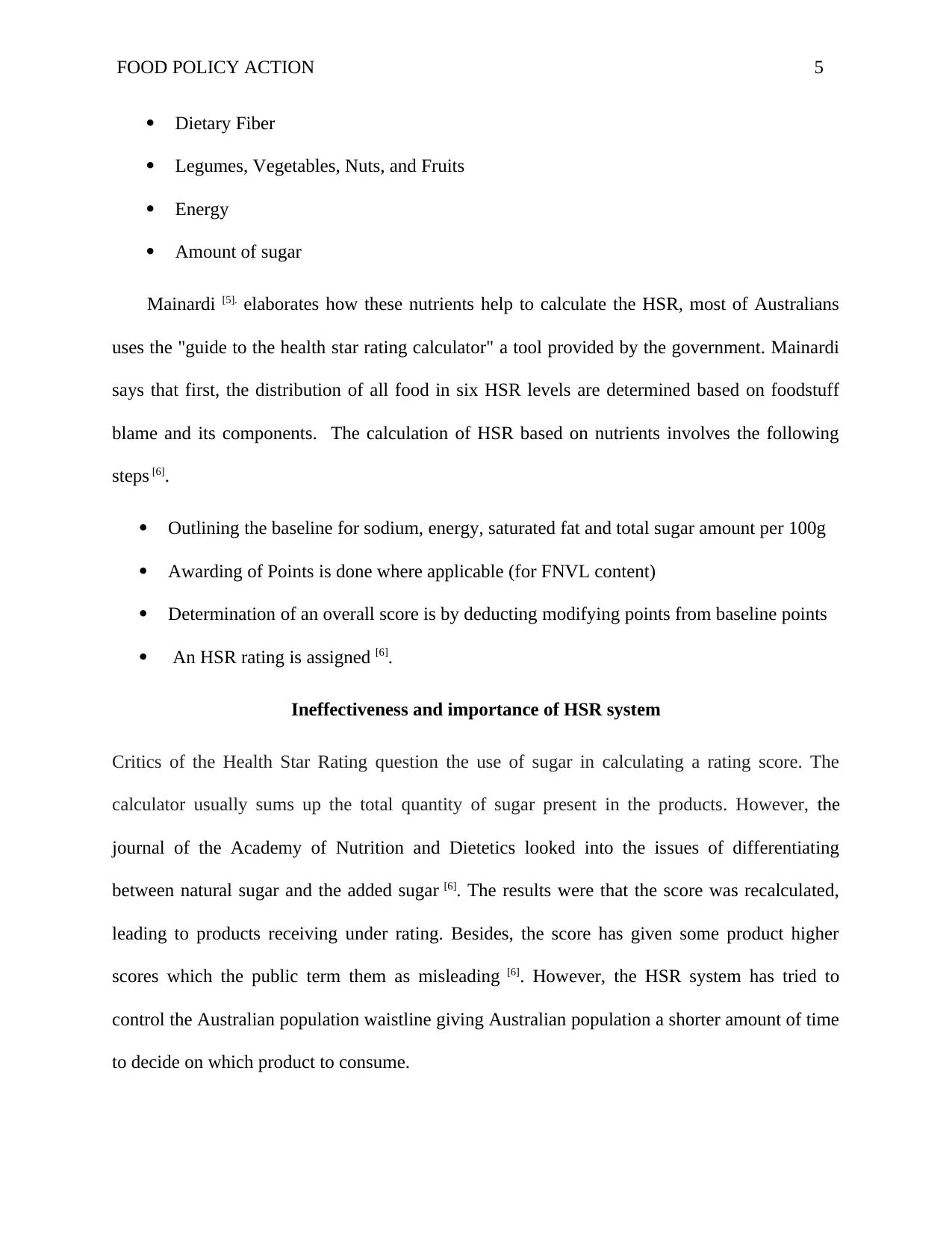
FOOD POLICY ACTION 5
Dietary Fiber
Legumes, Vegetables, Nuts, and Fruits
Energy
Amount of sugar
Mainardi [5]. elaborates how these nutrients help to calculate the HSR, most of Australians
uses the "guide to the health star rating calculator" a tool provided by the government. Mainardi
says that first, the distribution of all food in six HSR levels are determined based on foodstuff
blame and its components. The calculation of HSR based on nutrients involves the following
steps [6].
Outlining the baseline for sodium, energy, saturated fat and total sugar amount per 100g
Awarding of Points is done where applicable (for FNVL content)
Determination of an overall score is by deducting modifying points from baseline points
An HSR rating is assigned [6].
Ineffectiveness and importance of HSR system
Critics of the Health Star Rating question the use of sugar in calculating a rating score. The
calculator usually sums up the total quantity of sugar present in the products. However, the
journal of the Academy of Nutrition and Dietetics looked into the issues of differentiating
between natural sugar and the added sugar [6]. The results were that the score was recalculated,
leading to products receiving under rating. Besides, the score has given some product higher
scores which the public term them as misleading [6]. However, the HSR system has tried to
control the Australian population waistline giving Australian population a shorter amount of time
to decide on which product to consume.
Dietary Fiber
Legumes, Vegetables, Nuts, and Fruits
Energy
Amount of sugar
Mainardi [5]. elaborates how these nutrients help to calculate the HSR, most of Australians
uses the "guide to the health star rating calculator" a tool provided by the government. Mainardi
says that first, the distribution of all food in six HSR levels are determined based on foodstuff
blame and its components. The calculation of HSR based on nutrients involves the following
steps [6].
Outlining the baseline for sodium, energy, saturated fat and total sugar amount per 100g
Awarding of Points is done where applicable (for FNVL content)
Determination of an overall score is by deducting modifying points from baseline points
An HSR rating is assigned [6].
Ineffectiveness and importance of HSR system
Critics of the Health Star Rating question the use of sugar in calculating a rating score. The
calculator usually sums up the total quantity of sugar present in the products. However, the
journal of the Academy of Nutrition and Dietetics looked into the issues of differentiating
between natural sugar and the added sugar [6]. The results were that the score was recalculated,
leading to products receiving under rating. Besides, the score has given some product higher
scores which the public term them as misleading [6]. However, the HSR system has tried to
control the Australian population waistline giving Australian population a shorter amount of time
to decide on which product to consume.
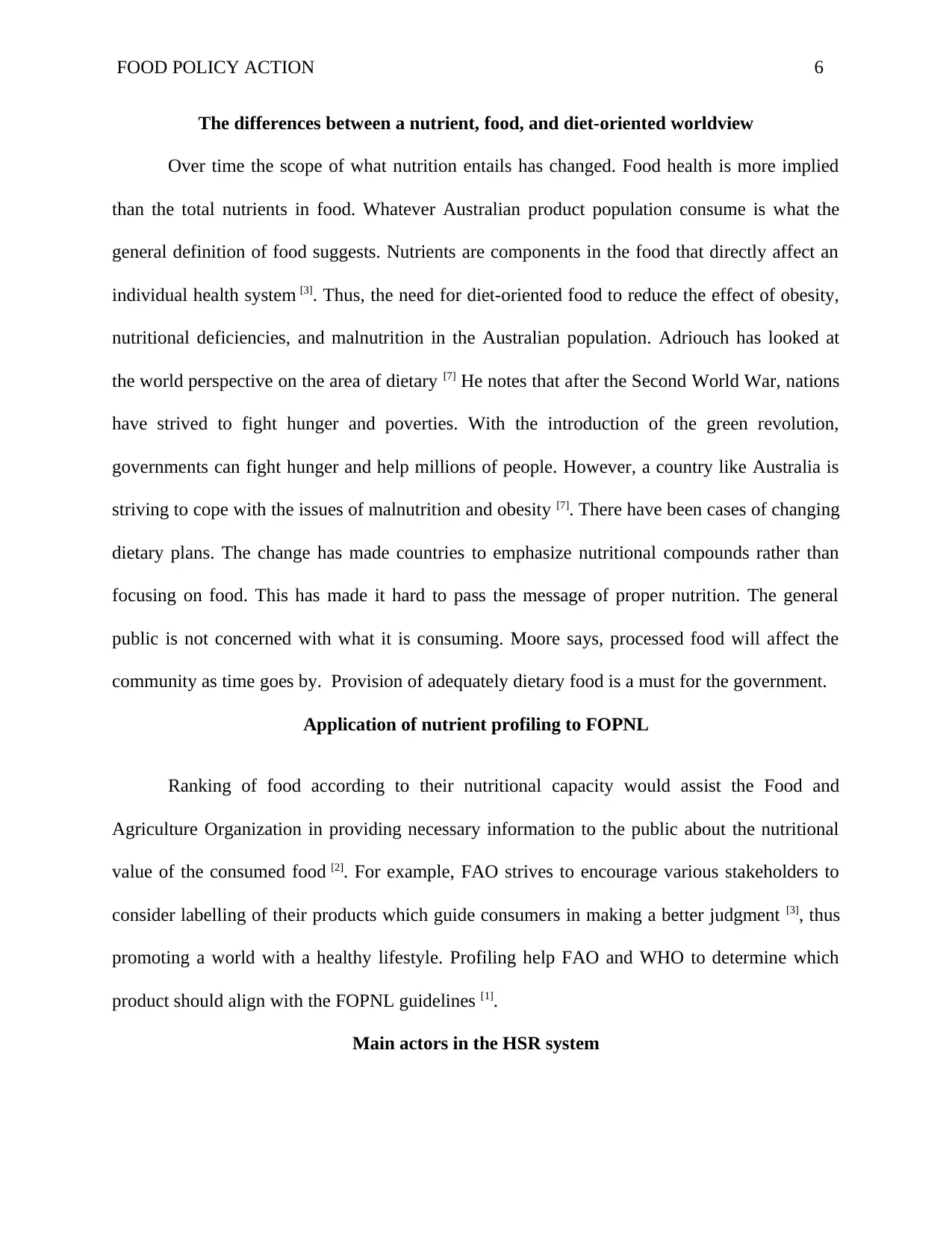
FOOD POLICY ACTION 6
The differences between a nutrient, food, and diet-oriented worldview
Over time the scope of what nutrition entails has changed. Food health is more implied
than the total nutrients in food. Whatever Australian product population consume is what the
general definition of food suggests. Nutrients are components in the food that directly affect an
individual health system [3]. Thus, the need for diet-oriented food to reduce the effect of obesity,
nutritional deficiencies, and malnutrition in the Australian population. Adriouch has looked at
the world perspective on the area of dietary [7] He notes that after the Second World War, nations
have strived to fight hunger and poverties. With the introduction of the green revolution,
governments can fight hunger and help millions of people. However, a country like Australia is
striving to cope with the issues of malnutrition and obesity [7]. There have been cases of changing
dietary plans. The change has made countries to emphasize nutritional compounds rather than
focusing on food. This has made it hard to pass the message of proper nutrition. The general
public is not concerned with what it is consuming. Moore says, processed food will affect the
community as time goes by. Provision of adequately dietary food is a must for the government.
Application of nutrient profiling to FOPNL
Ranking of food according to their nutritional capacity would assist the Food and
Agriculture Organization in providing necessary information to the public about the nutritional
value of the consumed food [2]. For example, FAO strives to encourage various stakeholders to
consider labelling of their products which guide consumers in making a better judgment [3], thus
promoting a world with a healthy lifestyle. Profiling help FAO and WHO to determine which
product should align with the FOPNL guidelines [1].
Main actors in the HSR system
The differences between a nutrient, food, and diet-oriented worldview
Over time the scope of what nutrition entails has changed. Food health is more implied
than the total nutrients in food. Whatever Australian product population consume is what the
general definition of food suggests. Nutrients are components in the food that directly affect an
individual health system [3]. Thus, the need for diet-oriented food to reduce the effect of obesity,
nutritional deficiencies, and malnutrition in the Australian population. Adriouch has looked at
the world perspective on the area of dietary [7] He notes that after the Second World War, nations
have strived to fight hunger and poverties. With the introduction of the green revolution,
governments can fight hunger and help millions of people. However, a country like Australia is
striving to cope with the issues of malnutrition and obesity [7]. There have been cases of changing
dietary plans. The change has made countries to emphasize nutritional compounds rather than
focusing on food. This has made it hard to pass the message of proper nutrition. The general
public is not concerned with what it is consuming. Moore says, processed food will affect the
community as time goes by. Provision of adequately dietary food is a must for the government.
Application of nutrient profiling to FOPNL
Ranking of food according to their nutritional capacity would assist the Food and
Agriculture Organization in providing necessary information to the public about the nutritional
value of the consumed food [2]. For example, FAO strives to encourage various stakeholders to
consider labelling of their products which guide consumers in making a better judgment [3], thus
promoting a world with a healthy lifestyle. Profiling help FAO and WHO to determine which
product should align with the FOPNL guidelines [1].
Main actors in the HSR system
⊘ This is a preview!⊘
Do you want full access?
Subscribe today to unlock all pages.

Trusted by 1+ million students worldwide
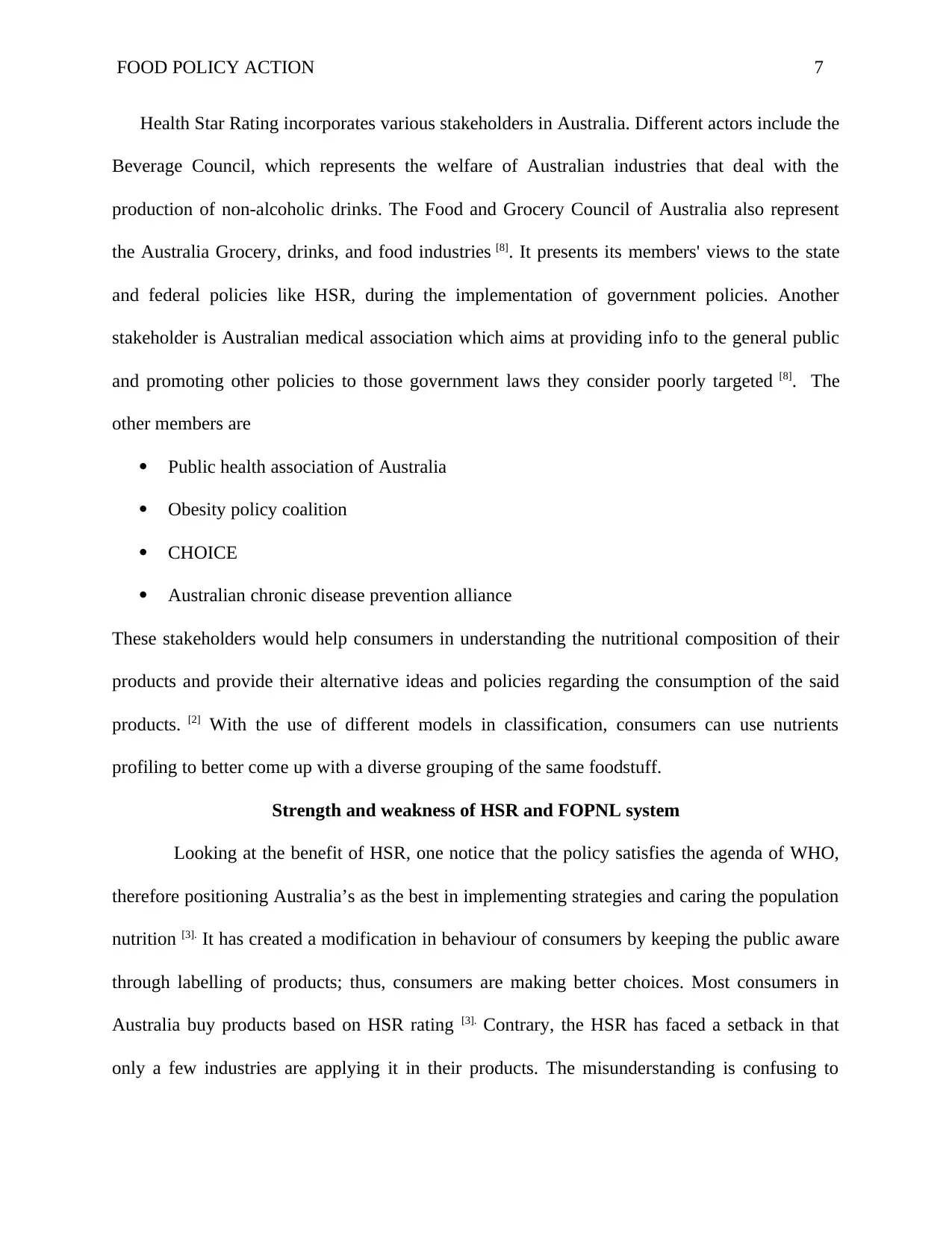
FOOD POLICY ACTION 7
Health Star Rating incorporates various stakeholders in Australia. Different actors include the
Beverage Council, which represents the welfare of Australian industries that deal with the
production of non-alcoholic drinks. The Food and Grocery Council of Australia also represent
the Australia Grocery, drinks, and food industries [8]. It presents its members' views to the state
and federal policies like HSR, during the implementation of government policies. Another
stakeholder is Australian medical association which aims at providing info to the general public
and promoting other policies to those government laws they consider poorly targeted [8]. The
other members are
Public health association of Australia
Obesity policy coalition
CHOICE
Australian chronic disease prevention alliance
These stakeholders would help consumers in understanding the nutritional composition of their
products and provide their alternative ideas and policies regarding the consumption of the said
products. [2] With the use of different models in classification, consumers can use nutrients
profiling to better come up with a diverse grouping of the same foodstuff.
Strength and weakness of HSR and FOPNL system
Looking at the benefit of HSR, one notice that the policy satisfies the agenda of WHO,
therefore positioning Australia’s as the best in implementing strategies and caring the population
nutrition [3]. It has created a modification in behaviour of consumers by keeping the public aware
through labelling of products; thus, consumers are making better choices. Most consumers in
Australia buy products based on HSR rating [3]. Contrary, the HSR has faced a setback in that
only a few industries are applying it in their products. The misunderstanding is confusing to
Health Star Rating incorporates various stakeholders in Australia. Different actors include the
Beverage Council, which represents the welfare of Australian industries that deal with the
production of non-alcoholic drinks. The Food and Grocery Council of Australia also represent
the Australia Grocery, drinks, and food industries [8]. It presents its members' views to the state
and federal policies like HSR, during the implementation of government policies. Another
stakeholder is Australian medical association which aims at providing info to the general public
and promoting other policies to those government laws they consider poorly targeted [8]. The
other members are
Public health association of Australia
Obesity policy coalition
CHOICE
Australian chronic disease prevention alliance
These stakeholders would help consumers in understanding the nutritional composition of their
products and provide their alternative ideas and policies regarding the consumption of the said
products. [2] With the use of different models in classification, consumers can use nutrients
profiling to better come up with a diverse grouping of the same foodstuff.
Strength and weakness of HSR and FOPNL system
Looking at the benefit of HSR, one notice that the policy satisfies the agenda of WHO,
therefore positioning Australia’s as the best in implementing strategies and caring the population
nutrition [3]. It has created a modification in behaviour of consumers by keeping the public aware
through labelling of products; thus, consumers are making better choices. Most consumers in
Australia buy products based on HSR rating [3]. Contrary, the HSR has faced a setback in that
only a few industries are applying it in their products. The misunderstanding is confusing to
Paraphrase This Document
Need a fresh take? Get an instant paraphrase of this document with our AI Paraphraser
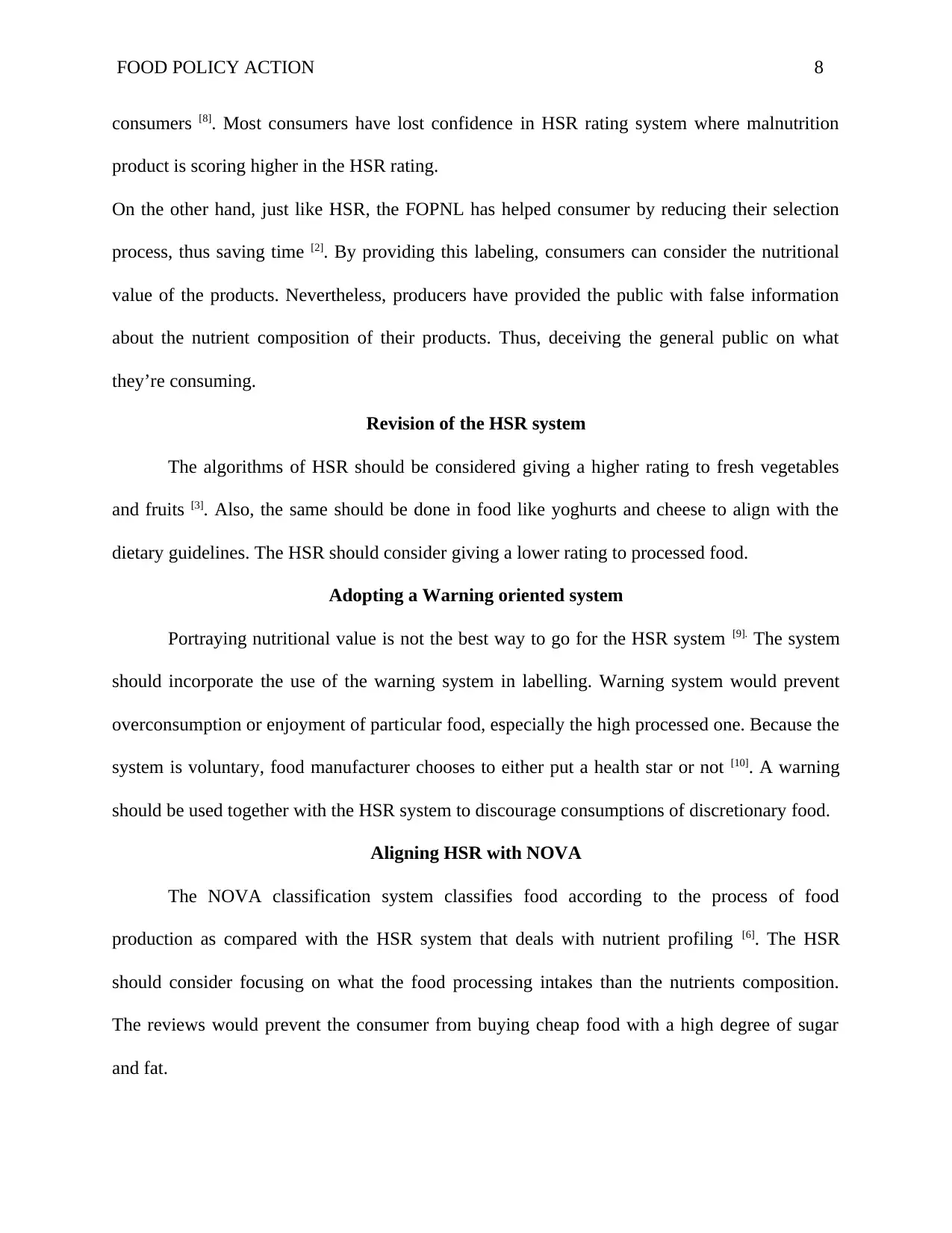
FOOD POLICY ACTION 8
consumers [8]. Most consumers have lost confidence in HSR rating system where malnutrition
product is scoring higher in the HSR rating.
On the other hand, just like HSR, the FOPNL has helped consumer by reducing their selection
process, thus saving time [2]. By providing this labeling, consumers can consider the nutritional
value of the products. Nevertheless, producers have provided the public with false information
about the nutrient composition of their products. Thus, deceiving the general public on what
they’re consuming.
Revision of the HSR system
The algorithms of HSR should be considered giving a higher rating to fresh vegetables
and fruits [3]. Also, the same should be done in food like yoghurts and cheese to align with the
dietary guidelines. The HSR should consider giving a lower rating to processed food.
Adopting a Warning oriented system
Portraying nutritional value is not the best way to go for the HSR system [9]. The system
should incorporate the use of the warning system in labelling. Warning system would prevent
overconsumption or enjoyment of particular food, especially the high processed one. Because the
system is voluntary, food manufacturer chooses to either put a health star or not [10]. A warning
should be used together with the HSR system to discourage consumptions of discretionary food.
Aligning HSR with NOVA
The NOVA classification system classifies food according to the process of food
production as compared with the HSR system that deals with nutrient profiling [6]. The HSR
should consider focusing on what the food processing intakes than the nutrients composition.
The reviews would prevent the consumer from buying cheap food with a high degree of sugar
and fat.
consumers [8]. Most consumers have lost confidence in HSR rating system where malnutrition
product is scoring higher in the HSR rating.
On the other hand, just like HSR, the FOPNL has helped consumer by reducing their selection
process, thus saving time [2]. By providing this labeling, consumers can consider the nutritional
value of the products. Nevertheless, producers have provided the public with false information
about the nutrient composition of their products. Thus, deceiving the general public on what
they’re consuming.
Revision of the HSR system
The algorithms of HSR should be considered giving a higher rating to fresh vegetables
and fruits [3]. Also, the same should be done in food like yoghurts and cheese to align with the
dietary guidelines. The HSR should consider giving a lower rating to processed food.
Adopting a Warning oriented system
Portraying nutritional value is not the best way to go for the HSR system [9]. The system
should incorporate the use of the warning system in labelling. Warning system would prevent
overconsumption or enjoyment of particular food, especially the high processed one. Because the
system is voluntary, food manufacturer chooses to either put a health star or not [10]. A warning
should be used together with the HSR system to discourage consumptions of discretionary food.
Aligning HSR with NOVA
The NOVA classification system classifies food according to the process of food
production as compared with the HSR system that deals with nutrient profiling [6]. The HSR
should consider focusing on what the food processing intakes than the nutrients composition.
The reviews would prevent the consumer from buying cheap food with a high degree of sugar
and fat.
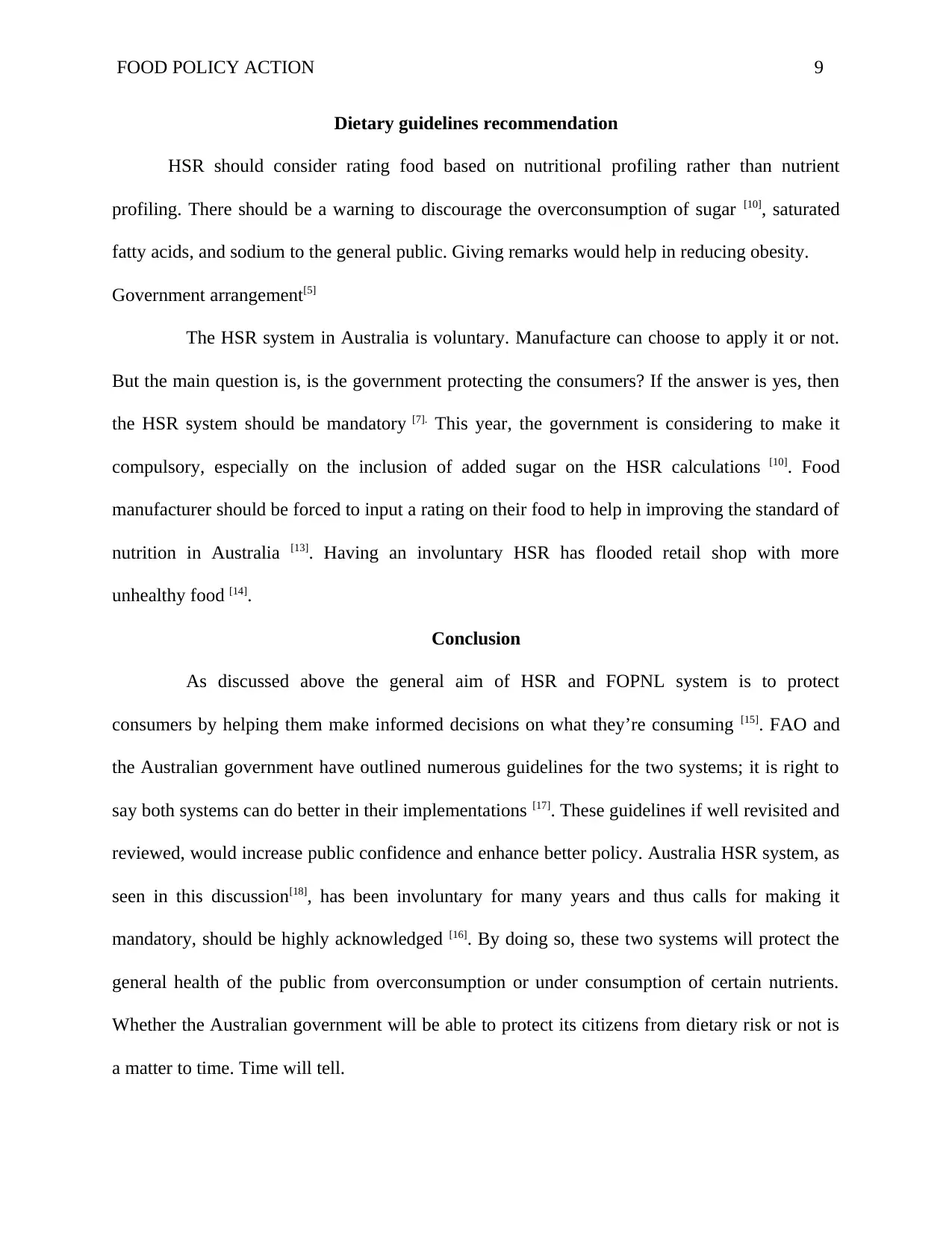
FOOD POLICY ACTION 9
Dietary guidelines recommendation
HSR should consider rating food based on nutritional profiling rather than nutrient
profiling. There should be a warning to discourage the overconsumption of sugar [10], saturated
fatty acids, and sodium to the general public. Giving remarks would help in reducing obesity.
Government arrangement[5]
The HSR system in Australia is voluntary. Manufacture can choose to apply it or not.
But the main question is, is the government protecting the consumers? If the answer is yes, then
the HSR system should be mandatory [7]. This year, the government is considering to make it
compulsory, especially on the inclusion of added sugar on the HSR calculations [10]. Food
manufacturer should be forced to input a rating on their food to help in improving the standard of
nutrition in Australia [13]. Having an involuntary HSR has flooded retail shop with more
unhealthy food [14].
Conclusion
As discussed above the general aim of HSR and FOPNL system is to protect
consumers by helping them make informed decisions on what they’re consuming [15]. FAO and
the Australian government have outlined numerous guidelines for the two systems; it is right to
say both systems can do better in their implementations [17]. These guidelines if well revisited and
reviewed, would increase public confidence and enhance better policy. Australia HSR system, as
seen in this discussion[18], has been involuntary for many years and thus calls for making it
mandatory, should be highly acknowledged [16]. By doing so, these two systems will protect the
general health of the public from overconsumption or under consumption of certain nutrients.
Whether the Australian government will be able to protect its citizens from dietary risk or not is
a matter to time. Time will tell.
Dietary guidelines recommendation
HSR should consider rating food based on nutritional profiling rather than nutrient
profiling. There should be a warning to discourage the overconsumption of sugar [10], saturated
fatty acids, and sodium to the general public. Giving remarks would help in reducing obesity.
Government arrangement[5]
The HSR system in Australia is voluntary. Manufacture can choose to apply it or not.
But the main question is, is the government protecting the consumers? If the answer is yes, then
the HSR system should be mandatory [7]. This year, the government is considering to make it
compulsory, especially on the inclusion of added sugar on the HSR calculations [10]. Food
manufacturer should be forced to input a rating on their food to help in improving the standard of
nutrition in Australia [13]. Having an involuntary HSR has flooded retail shop with more
unhealthy food [14].
Conclusion
As discussed above the general aim of HSR and FOPNL system is to protect
consumers by helping them make informed decisions on what they’re consuming [15]. FAO and
the Australian government have outlined numerous guidelines for the two systems; it is right to
say both systems can do better in their implementations [17]. These guidelines if well revisited and
reviewed, would increase public confidence and enhance better policy. Australia HSR system, as
seen in this discussion[18], has been involuntary for many years and thus calls for making it
mandatory, should be highly acknowledged [16]. By doing so, these two systems will protect the
general health of the public from overconsumption or under consumption of certain nutrients.
Whether the Australian government will be able to protect its citizens from dietary risk or not is
a matter to time. Time will tell.
⊘ This is a preview!⊘
Do you want full access?
Subscribe today to unlock all pages.

Trusted by 1+ million students worldwide
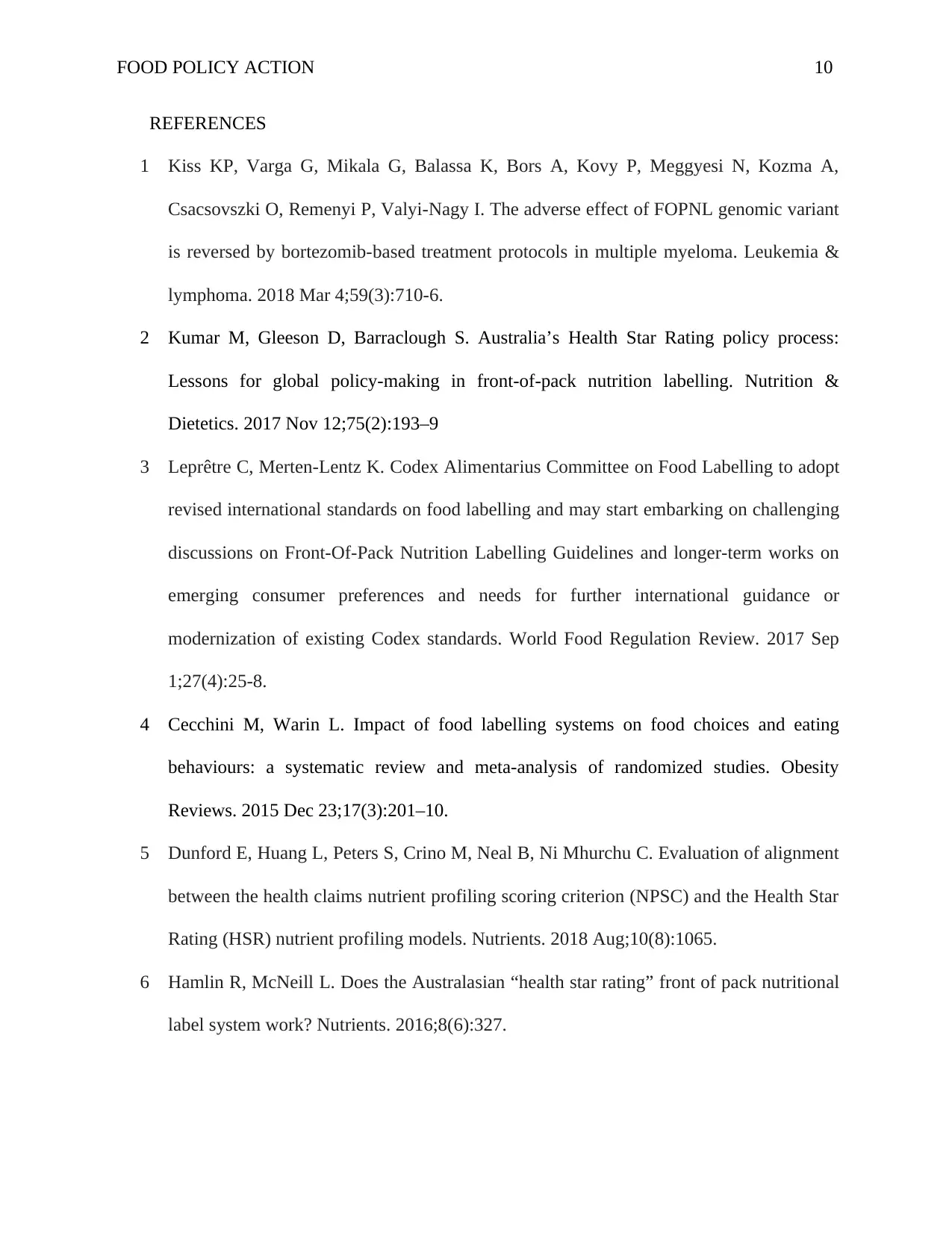
FOOD POLICY ACTION 10
REFERENCES
1 Kiss KP, Varga G, Mikala G, Balassa K, Bors A, Kovy P, Meggyesi N, Kozma A,
Csacsovszki O, Remenyi P, Valyi-Nagy I. The adverse effect of FOPNL genomic variant
is reversed by bortezomib-based treatment protocols in multiple myeloma. Leukemia &
lymphoma. 2018 Mar 4;59(3):710-6.
2 Kumar M, Gleeson D, Barraclough S. Australia’s Health Star Rating policy process:
Lessons for global policy-making in front-of-pack nutrition labelling. Nutrition &
Dietetics. 2017 Nov 12;75(2):193–9
3 Leprêtre C, Merten-Lentz K. Codex Alimentarius Committee on Food Labelling to adopt
revised international standards on food labelling and may start embarking on challenging
discussions on Front-Of-Pack Nutrition Labelling Guidelines and longer-term works on
emerging consumer preferences and needs for further international guidance or
modernization of existing Codex standards. World Food Regulation Review. 2017 Sep
1;27(4):25-8.
4 Cecchini M, Warin L. Impact of food labelling systems on food choices and eating
behaviours: a systematic review and meta-analysis of randomized studies. Obesity
Reviews. 2015 Dec 23;17(3):201–10.
5 Dunford E, Huang L, Peters S, Crino M, Neal B, Ni Mhurchu C. Evaluation of alignment
between the health claims nutrient profiling scoring criterion (NPSC) and the Health Star
Rating (HSR) nutrient profiling models. Nutrients. 2018 Aug;10(8):1065.
6 Hamlin R, McNeill L. Does the Australasian “health star rating” front of pack nutritional
label system work? Nutrients. 2016;8(6):327.
REFERENCES
1 Kiss KP, Varga G, Mikala G, Balassa K, Bors A, Kovy P, Meggyesi N, Kozma A,
Csacsovszki O, Remenyi P, Valyi-Nagy I. The adverse effect of FOPNL genomic variant
is reversed by bortezomib-based treatment protocols in multiple myeloma. Leukemia &
lymphoma. 2018 Mar 4;59(3):710-6.
2 Kumar M, Gleeson D, Barraclough S. Australia’s Health Star Rating policy process:
Lessons for global policy-making in front-of-pack nutrition labelling. Nutrition &
Dietetics. 2017 Nov 12;75(2):193–9
3 Leprêtre C, Merten-Lentz K. Codex Alimentarius Committee on Food Labelling to adopt
revised international standards on food labelling and may start embarking on challenging
discussions on Front-Of-Pack Nutrition Labelling Guidelines and longer-term works on
emerging consumer preferences and needs for further international guidance or
modernization of existing Codex standards. World Food Regulation Review. 2017 Sep
1;27(4):25-8.
4 Cecchini M, Warin L. Impact of food labelling systems on food choices and eating
behaviours: a systematic review and meta-analysis of randomized studies. Obesity
Reviews. 2015 Dec 23;17(3):201–10.
5 Dunford E, Huang L, Peters S, Crino M, Neal B, Ni Mhurchu C. Evaluation of alignment
between the health claims nutrient profiling scoring criterion (NPSC) and the Health Star
Rating (HSR) nutrient profiling models. Nutrients. 2018 Aug;10(8):1065.
6 Hamlin R, McNeill L. Does the Australasian “health star rating” front of pack nutritional
label system work? Nutrients. 2016;8(6):327.
Paraphrase This Document
Need a fresh take? Get an instant paraphrase of this document with our AI Paraphraser
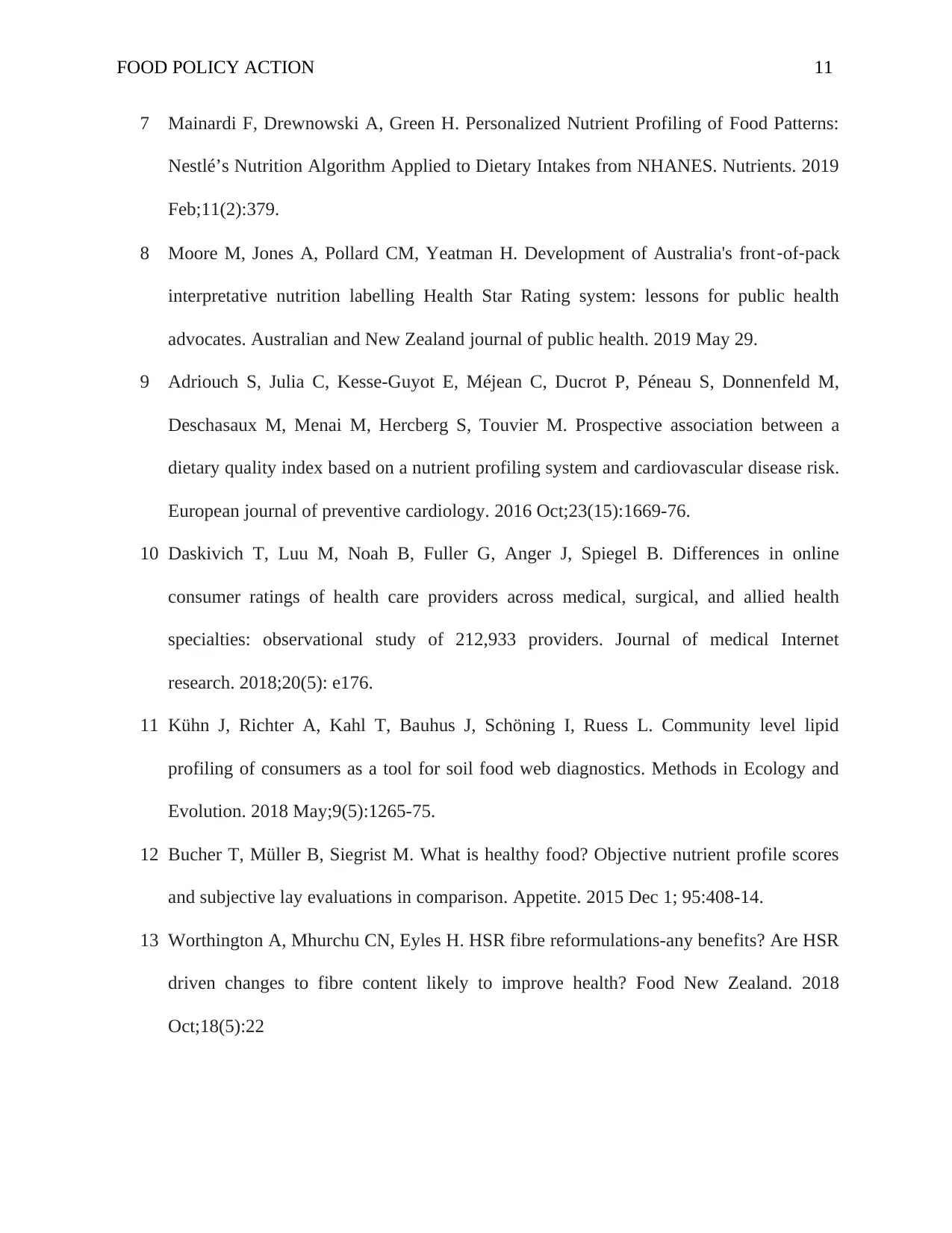
FOOD POLICY ACTION 11
7 Mainardi F, Drewnowski A, Green H. Personalized Nutrient Profiling of Food Patterns:
Nestlé’s Nutrition Algorithm Applied to Dietary Intakes from NHANES. Nutrients. 2019
Feb;11(2):379.
8 Moore M, Jones A, Pollard CM, Yeatman H. Development of Australia's front‐of‐pack
interpretative nutrition labelling Health Star Rating system: lessons for public health
advocates. Australian and New Zealand journal of public health. 2019 May 29.
9 Adriouch S, Julia C, Kesse-Guyot E, Méjean C, Ducrot P, Péneau S, Donnenfeld M,
Deschasaux M, Menai M, Hercberg S, Touvier M. Prospective association between a
dietary quality index based on a nutrient profiling system and cardiovascular disease risk.
European journal of preventive cardiology. 2016 Oct;23(15):1669-76.
10 Daskivich T, Luu M, Noah B, Fuller G, Anger J, Spiegel B. Differences in online
consumer ratings of health care providers across medical, surgical, and allied health
specialties: observational study of 212,933 providers. Journal of medical Internet
research. 2018;20(5): e176.
11 Kühn J, Richter A, Kahl T, Bauhus J, Schöning I, Ruess L. Community level lipid
profiling of consumers as a tool for soil food web diagnostics. Methods in Ecology and
Evolution. 2018 May;9(5):1265-75.
12 Bucher T, Müller B, Siegrist M. What is healthy food? Objective nutrient profile scores
and subjective lay evaluations in comparison. Appetite. 2015 Dec 1; 95:408-14.
13 Worthington A, Mhurchu CN, Eyles H. HSR fibre reformulations-any benefits? Are HSR
driven changes to fibre content likely to improve health? Food New Zealand. 2018
Oct;18(5):22
7 Mainardi F, Drewnowski A, Green H. Personalized Nutrient Profiling of Food Patterns:
Nestlé’s Nutrition Algorithm Applied to Dietary Intakes from NHANES. Nutrients. 2019
Feb;11(2):379.
8 Moore M, Jones A, Pollard CM, Yeatman H. Development of Australia's front‐of‐pack
interpretative nutrition labelling Health Star Rating system: lessons for public health
advocates. Australian and New Zealand journal of public health. 2019 May 29.
9 Adriouch S, Julia C, Kesse-Guyot E, Méjean C, Ducrot P, Péneau S, Donnenfeld M,
Deschasaux M, Menai M, Hercberg S, Touvier M. Prospective association between a
dietary quality index based on a nutrient profiling system and cardiovascular disease risk.
European journal of preventive cardiology. 2016 Oct;23(15):1669-76.
10 Daskivich T, Luu M, Noah B, Fuller G, Anger J, Spiegel B. Differences in online
consumer ratings of health care providers across medical, surgical, and allied health
specialties: observational study of 212,933 providers. Journal of medical Internet
research. 2018;20(5): e176.
11 Kühn J, Richter A, Kahl T, Bauhus J, Schöning I, Ruess L. Community level lipid
profiling of consumers as a tool for soil food web diagnostics. Methods in Ecology and
Evolution. 2018 May;9(5):1265-75.
12 Bucher T, Müller B, Siegrist M. What is healthy food? Objective nutrient profile scores
and subjective lay evaluations in comparison. Appetite. 2015 Dec 1; 95:408-14.
13 Worthington A, Mhurchu CN, Eyles H. HSR fibre reformulations-any benefits? Are HSR
driven changes to fibre content likely to improve health? Food New Zealand. 2018
Oct;18(5):22
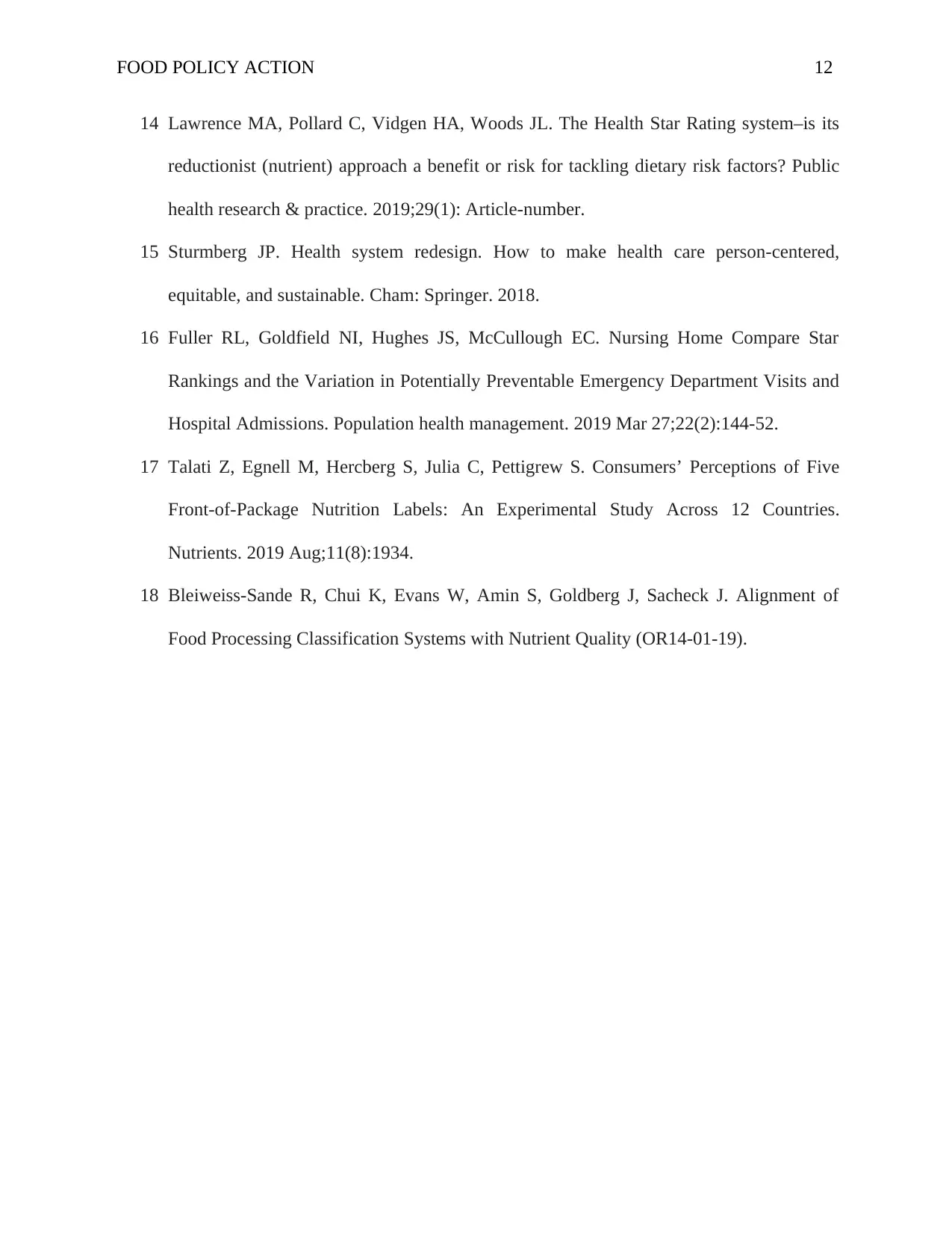
FOOD POLICY ACTION 12
14 Lawrence MA, Pollard C, Vidgen HA, Woods JL. The Health Star Rating system–is its
reductionist (nutrient) approach a benefit or risk for tackling dietary risk factors? Public
health research & practice. 2019;29(1): Article-number.
15 Sturmberg JP. Health system redesign. How to make health care person-centered,
equitable, and sustainable. Cham: Springer. 2018.
16 Fuller RL, Goldfield NI, Hughes JS, McCullough EC. Nursing Home Compare Star
Rankings and the Variation in Potentially Preventable Emergency Department Visits and
Hospital Admissions. Population health management. 2019 Mar 27;22(2):144-52.
17 Talati Z, Egnell M, Hercberg S, Julia C, Pettigrew S. Consumers’ Perceptions of Five
Front-of-Package Nutrition Labels: An Experimental Study Across 12 Countries.
Nutrients. 2019 Aug;11(8):1934.
18 Bleiweiss-Sande R, Chui K, Evans W, Amin S, Goldberg J, Sacheck J. Alignment of
Food Processing Classification Systems with Nutrient Quality (OR14-01-19).
14 Lawrence MA, Pollard C, Vidgen HA, Woods JL. The Health Star Rating system–is its
reductionist (nutrient) approach a benefit or risk for tackling dietary risk factors? Public
health research & practice. 2019;29(1): Article-number.
15 Sturmberg JP. Health system redesign. How to make health care person-centered,
equitable, and sustainable. Cham: Springer. 2018.
16 Fuller RL, Goldfield NI, Hughes JS, McCullough EC. Nursing Home Compare Star
Rankings and the Variation in Potentially Preventable Emergency Department Visits and
Hospital Admissions. Population health management. 2019 Mar 27;22(2):144-52.
17 Talati Z, Egnell M, Hercberg S, Julia C, Pettigrew S. Consumers’ Perceptions of Five
Front-of-Package Nutrition Labels: An Experimental Study Across 12 Countries.
Nutrients. 2019 Aug;11(8):1934.
18 Bleiweiss-Sande R, Chui K, Evans W, Amin S, Goldberg J, Sacheck J. Alignment of
Food Processing Classification Systems with Nutrient Quality (OR14-01-19).
⊘ This is a preview!⊘
Do you want full access?
Subscribe today to unlock all pages.

Trusted by 1+ million students worldwide
1 out of 12
Related Documents
Your All-in-One AI-Powered Toolkit for Academic Success.
+13062052269
info@desklib.com
Available 24*7 on WhatsApp / Email
![[object Object]](/_next/static/media/star-bottom.7253800d.svg)
Unlock your academic potential
Copyright © 2020–2025 A2Z Services. All Rights Reserved. Developed and managed by ZUCOL.


